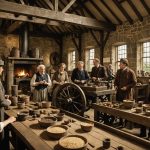Overview of Traditional British Lace-Making
Traditional British lace-making is a cornerstone of the nation’s cultural heritage, signifying the remarkable craftsmanship of artisanal crafts. Tracing its roots back to the 16th century, lace-making enjoyed royal patronage and became synonymous with Britain’s rich textile history. Over time, it transformed into an emblem of status and sophistication, celebrated across the globe.
The distinct types of lace, such as bobbin lace and needle lace, are recognized for their intricate patterns and delicate arrangements. Bobbin lace, also known as bone lace, involves the use of bobbins wound with threads, meticulously interwoven to craft beautiful designs. Needle lace, on the other hand, uses a single needle and thread to produce embroidered lace, noted for its lightweight and elaborate forms.
Topic to read : Discover Engaging Interactive Experiences on the Rich History of British Mills for Tourists
Preserving these traditional crafts is crucial in bolstering modern tourism. Visitors are often mesmerized by live demonstrations and the opportunity to engage in workshops to learn these ancient skills. This not only sustains the art of lace-making but ensures its continuation as a treasured piece of cultural heritage. As the demand for authentic cultural experiences grows, the significance of protecting and promoting traditional British lace-making becomes ever more vital to sustaining its legacy.
Recommended British Lace-Making Workshops
Embark on a captivating journey through the Best Lace-Making Workshops that England has to offer. Whether you’re a local enthusiast or seeking enriching tourist experiences, these workshops provide practical skills alongside cultural engagement.
Also to discover : Discover the Most Captivating Tours Exploring the Evolution of British Military Strategy
Workshop 1: [Crafting Traditions]
Nestled in the heart of London, [Crafting Traditions] offers convenient accessibility via public transport. This workshop immerses attendees in both basic and advanced lace-making techniques. Spanning over three days, this lace-making experience balances learning with hands-on crafting. The total cost is £150, inclusive of materials. Participants can secure their spot by booking online.
Workshop 2: [Lace Masters Studio]
Situated in Birmingham, [Lace Masters Studio] is easily accessible by car and train. This enriching one-day workshop equips participants with foundational skills needed for intricate lace designs. Priced at £75, the session includes lunch and all necessary materials. Booking can be done via phone or through their user-friendly website.
Workshop 3: [Heritage Weaves]
Found in the picturesque town of Bath, [Heritage Weaves] offers a unique two-day course covering traditional techniques. Participants can explore complex patterns under expert guidance. The workshop fee is £120, with early bird discounts available. Registration is straightforward through their online booking system.
Discovering these workshops provides an excellent opportunity for exploring creativity with a cultural twist.
Participant Expectations and Experience
Participants in lace-making workshops can expect an immersive and enriching experience. Each workshop provides all necessary materials, ensuring that individuals can focus entirely on developing their lace-making skills. From intricate bobbins to delicate threads, everything is meticulously arranged to enhance the learning process.
Many participants have shared glowing testimonials, revealing a high level of engagement throughout the sessions. These statements frequently highlight significant skill development, as individuals often begin with little to no previous lace-making experience. Through dedicated practice and guidance, participants find themselves proficiently crafting beautiful lace designs, a testament to the workshop’s effectiveness.
A notable element of these workshops is the fostering of a strong sense of community. Individuals from various backgrounds come together, sharing not only skills but also cultural stories and traditions. This exchange enriches the experience, as participants not only learn a new craft but also gain insights into diverse cultural perspectives.
The workshops provide an environment where participants move beyond just acquiring new skills. The journey includes personal growth and a deeper appreciation for the art of lace-making, forming connections that continue beyond the duration of the workshop. This unique experience leaves a lasting positive impact on each participant, encouraging them to explore further into the world of lace-making.
Cultural Significance of Lace-Making in Britain
Lace-making, interwoven with British craft traditions, offers insight into British socio-economic history. Once a cornerstone of craftsmanship, its historical context dates back to the 16th century, with origins in places like Devon and Buckinghamshire. These regions were renowned hubs for their intricate lace patterns, favoured by aristocrats and royals alike.
Historically, lace-making burgeoned within the domestic sphere, contributing significantly to local economies. Women and young girls often engaged in this delicate art, transforming it into a family-driven industry. Their skillful handiwork not only generated income but also fostered strong community bonds.
However, the advent of globalization and industrialization shifted the landscape, both expanding and challenging this age-old craft. Machine-made lace, though more accessible, diluted cultural significance, presenting a paradox for traditional artisans. The global market offered economic opportunities but at the cost of diminishing ancient methods.
The role of lace-making within regions remains a symbol of cultural heritage, connecting modern Britain with its intricate past. Revival initiatives, aimed at preserving techniques, underscore its lasting value. These efforts to sustain lace’s cultural imprint speak volumes of its enduring legacy within British society, balancing between progress and tradition.
Nearby Attractions and Itinerary Suggestions
Exploring the captivating cityscape near lace-making workshops can enrich your visit not just through hands-on activities but also through cultural immersion. Incorporating nearby attractions can enhance your experience and deepen your connection with local traditions.
Start your itinerary with lace-making workshops and pair them with visits to nearby museums showcasing the history of lace. These sites often feature historical cultural experiences, providing a broader understanding of the craft.
Include a stroll through the charming streets lined with artisan shops where you can purchase unique lace products and other cultural artifacts. This can be a delightful way to support local craftsmen and take a piece of the culture home.
For a balanced itinerary, spread your activities through the day and consider visiting local markets. Here, you can dive into the culinary side of the culture, enjoying regional specialties in quaint cafes or renowned restaurants.
Finally, allow time for relaxation in local parks or gardens, offering a serene setting to reflect on the day’s experiences. By balancing tourist itineraries with these suggestions, you can create a fulfilling journey that captures both historical richness and everyday life.
















